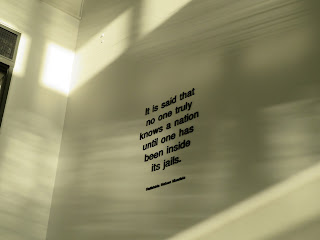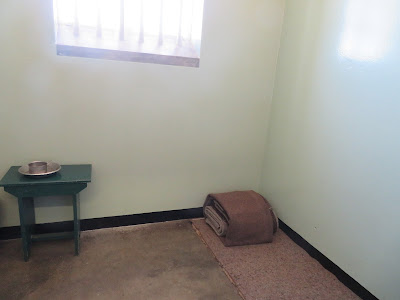Day 81 Wed. Apr 5 Cape Town, South Africa
Robben Island 4.5 hours. Walk to the clock tower at Precinct and Nelson Mandela gateway. Board the ferry to Robben Island. Take a panoramic tour of the island by bus and a guided walking tour through the maximum security block. Ride the ferry back to port and drive back to the pier.
Ponder the struggle against apartheid at Robben Island, a UNESCO World Heritage site best known as the prison where Nelsom Mandela was incarcerated. You’ll learn that for over four centuries, Robben Island was a place for punishment for exiles and criminals as well as a place of confinement for lepers, lunatics, and the sick, and from 1960 was used by the apartheid regie to isolate political prisoners such as Mandela. Discover that the last of the political inmates was released in 1991 and the site subsequently opened to the public as the Robben Island Museum, with many of the former political prisoners becoming guides. After a pleasant ferry ride with Capetown and Table Mountain as your backdrop, arrive at Robben Island and board a bus for a 45-minute orientation drive, seeing the leper colony, a Muslim shrine and a shipwreck before visiting the limestone quarry where political inmates performed backbreaking labor. Embark on an approximately 45-minute walking tour through the maximum-security block and cherish an opportunity to look in Mandela’s compact former cell. As you return to the mainland by ferry, let your thoughts linger on this stirring and uplifting sojourn.
Table Mountain
The prisoners were very supportive of one another. Political prisoners often educated the prisoners who were not educated. They were very creative in managing this education.
The bus ride around the island allowed us to see the cemetery where the lepers, prisoners and others were buried. There were several places where a group of buildings could be found. About one-half of the buildings are currently occupied. The rent is far more affordable than Cape Town but there are no stores, schools, health services, etc. Lighthouse on Goree Island
Robert Mangaliso Sobukwe was a South African Anti-Apartheid revolutionary. In March of 1960, Sobukwe organized a non-violent protest and was sentenced to three years in prison. In 1963, a special Sobukwe Clause allowed for this prison sentence to be renewed indefinitely. He was relocated to Robben Island for solitary confinement. After six years, he was released and place under house arrest until he died.
I never heard of Sobukwe, but he was thought of as a lot of trouble. He was arrested during a protest when he turned his pass in to a police officer which made him quilty of being present in an area where he wasn’t allowed without his pass. In a similar protest in Sharpeville, police opened fire and killed 69 in the Sharpeville, Massacre. Sobukwe lived in this seperate house and studied to achieve a degree in economics from the University of London. The South African government profiled him as a greater troublemaker. Under house arrest, he continued his education and became a lawyer. “There is only one race to which we all belong, and that is the human race. In our vocabulary therefore, The word “race” as applied to man, has no plural form.”
There were several buildings on the Sobukwe site.
The cave where the prisoners ate and used the bathroom.
Nelson Mandela's cell
This man was a former prisoner and he now gives tours and talks about Mandela.
Nelson Mandela quotes “To plant a seed, watch it grow, to tend it and then harvest it, offered a simple but enduring satisfaction. The sense of being the custodian of this small patch of earth offered a taste of freedom”.
“Like the gardener, a leader must take reponsibility for what he cultivates; he must mind his work, try to repel enemies, preserve what can be preserved, and eliminate what cannot succeed.”
The courtyard where Mandela and his fellow political prisoners planted gardens and spent time together.
















No comments:
Post a Comment